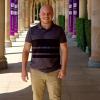Open Superconducting Quantum Computers
Bayerische Akademie der Wissenschaften (BAdW), Walter-Meissner-Institut (WMI), Leibniz-Rechenzentrum (LRZ)
Technische Universiteit Delft (TU Delft)
Commissarait à l’Energie Atomique et aux Energies Alternatives (CEA)
Universidad del País Vasco/Euskal Herriko Unibersitatea (UPV/EHU)
Teknologian Tutkimuskeskus VTT Oy (VTT)
Qruise GmbH (Qruise)
Bluefors Cryogenics Oy (Bluefors)
Tartu Ülikool (UTartu)
QuantWare B.V. (Quantware)
AALTO Korkeakoulusaatio SR (AALTO)
Centre national de la recherche scientifique (cnrs), Institut (NEEL)
Institute of Science and Technology Austria (IST Austria)
Wigner Fizikai Kutatokozpont (Wigner RCP)
Karlsruher Institut für Technologie (KIT)
ALICE & BOB (A&B)
IQM Finland Oy (IQM)
Budapesti Muszaki es Gazdasagtudomanyi Egyetem (BME)
Supracon AG (SUPRA)
CSC-Tieteen tietotekniikan keskus OY (CSC)
The Hebrew University of Jerusalem (HUJI)
Fraunhofer Gesellschaft zur Forderung der angewandten Forschung e.V (FHG), Fraunhofer Research Institution for Microsystems and Solid State Technologies (EMFT)
Nederlandse Organisatie voor toegepast Natuurwetenschappelijk onderzoek TNO (TNO)
Rohde & Schwarz GmbH und Co. KG (R&S)
Zurich Instruments Germany GmbH (ZI)
Orange Quantum Systems Operational Bv (OrangeQS)
European Research and Project Office GmbH (Eurice)
Objective:
The OpenSuperQplus consortium is a structured partnership aiming at large-scale European quantum computers in the superconducting platform. It proposes and implements a set of roadmaps covering the complete technology stack including quantum hardware, enabling hard- and software, engineering, and an application-driven test suite. It will implement and guide twospecific grant agreements (SGAs), aiming at 100 and 1000 qubits with high fidelity, respectively. Grown out of the ramp-up project OpenSuperQ, it brings together a community of excellent academic groups, RTOs, and companies of various sizes spread over Europe, and that includes widening countries. Industrial partners allow to commercialize components, enabling technologies as well as full machines. Its scientific focus is on high coherence, which is crucial to reach the break-even point of quantum advantage in NISQ and reaching out to fault tolerance. Beyond the SGAs, OpenSuperQplus will collaborate with many other Flagship projects, contribute to standardization through CEN/CENELEC, and form a sustainable partnership in the form of a professional organization.
OpenSuperQPlus aims to implement and oversee SGAs that build general-purpose quantum processors based on superconducting quantum circuits. In the first phase, SGA 1 will aim at reaching 100 qubits by 2025 and developing technological components and solutions needed to go beyond. In the second phase, SGA 2 will aim at systems of 1000 qubits by 2029. These goals will be reached with complementary approaches: On the 100-qubit level, we will team up with well-funded national initiatives and explore application-adapted strategies (co-designs) and grow existing high-quality fabrication capabilities to that scale. For the 1000-qubit level, we will narrow down to a small number of designs based on industry-compatible fabrication technology and develop a central system.
Besides the goal to increase the number of qubits in an extensible quantum-hardware (HW) architecture, we emphasize the importance of high yield, fidelity, and coherence of all the constituent elements. A large number of qubits does not yield advantage if the fidelity of operations (limited by coherence, crosstalk, and other factors) is not sufficiently high. Scaling devices to a larger number of qubits can only be done if new control electronics, OpenSuperQPlus interconnect solutions, and cryogenic infrastructure are simultaneously explored, which will enable a quantum computer (QC) to be built and continuously operated in a cost-efficient and automated manner. A holistic performance indicator will be the successful execution of (application-driven) algorithms involving all N qubits on the processor and benchmarking against the target of large quantum volumes. While the focus of the FPA is on NISQ applications, our architectural choices will reflect compatibility with the additional requirements imposed by fault-tolerant quantum computation and quantum error correction, such as leakage mitigation, non-demolition quantum parity measurements, and repeatability and parallelizability of gates.


